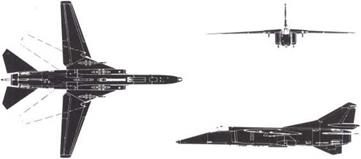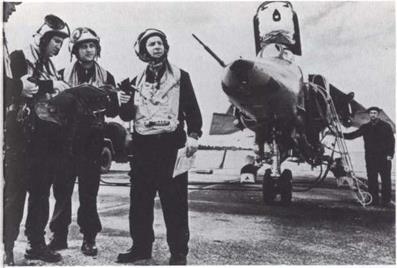Mikoyan/Gurevich MiG-27
MiG-27 "Flogger D” and "Flogger F"
Origin: The design bureau named for. Mikoyan and Gurevich,. Soviet Union: no production outside the Soviet Union yet reported.
Type: Single-seat tactical attack, probably with reconnaissance capability. Engine: One Tumansky R-29B afterburning turbofan rated at 17,6401b (8000kg) dry and 25,3501b (11,500kg) with full afterburner. Dimensions: Similar to MiG-23 except fuselage nose is longer but pitot head shorter giving fractionally shorter overall length: height about 1 5ft (4-6m).
Weights (estimated): Empty 17,3001b (7850kg): maximum loaded 44,3101b (20,100kg).
Performance: Maximum speed at low level (clean) about Mach 10, (maximum weight) subsonic: maximum speed at high altitude (clean) about 1,055mph (1700km/h, Mach 1 -6): take-off to 50ft (1 5m) at 34,600lb (15,700kg) 2,625ft (800m): service ceiling (clean) about 50,000ft (15,250m): combat radius with bombs and one tank (hi-lo-hi) 600 miles (960km): ferry range (wings spread with three tanks) over 2,000 miles (3200km).
Armament: One 23mm six-barrel Gatling-type gun in belly fairing: seven external pylons (centreline, fuselage flanks under inlet ducts, fixed wing gloves and swing-wings) for wide range of ordnance including guided missiles (AS-7 "Kerry") and tactical nuclear weapons to total weight of 4,200lb (1900kg). All ECM are internal and all’pylons are thus usable by weapons or tanks. Those on the outer wings are not always fitted: they are piped for drop tanks, but do not pivot and thus may be loaded only when the wings remain unswept.
History: First flight, possibly about 1970: service delivery, before 1974. Users: Cuba, Egypt, E Germany, Iraq, Poland, Soviet Union, Syria.
Development: Derived from the same variable-geometry prototype flown by the MiG bureau at the 1967 Aviation Day. this aircraft was at first called ”MiG-23B" in the West but is now known to have a different Soviet service designation that is almost certainly MiG-27. Bureau numbers are generally unknown for the MiG series: Mikoyan himself died in December 1970 and Gurevich in November 1976. and recent designs are known only by their service numbers. Compared with the MiG-23 this attack version carries heavier loads and is simpler and optimised for low-level operation. The airframe differs in having a shallower nose with a flat pointed profile housing mapping/terrain-following radar, laser ranger, doppler radar and radio altimeter, with good pilot view ahead and downward. The cockpit is heavily armoured. The engine is more powerful than that of the MiG-23 but is fed by fixed inlets and has a shorter and simpler nozzle. Main wheels are fitted with large low-pressure tyres, and special provision is made for rough-field operation. Internal ECM equipment is extensive, and pods on the wing-glove leading edges appear to contain an opto-electronic seeker (left) and passive radar receiver (right). Internal fuel capacity is estimated at 1,1 83 Imp gallons
|
|
Above: Three-view of MiG-27 without swing-wing pylons.
(5380lit) including fuel in the fin: no provision for flight refuelling has been noted. The "Flogger F” has the engine installation and gun of the MiG-23, with variable inlets, and lack the comprehensive MiG-27 avionics. These are thought to be development aircraft or an export version. Possible problems with the basic aircraft are suggested by reports that in a few months the Syrian AF has written off 13 out of 50 supplied.
|
|
Above: Russian pilots pose for a propaganda picture in front of their extremely well-equipped MiG-27 ‘Flogger-D’ attack aircraft.
Below: Egyptian ‘Flogger-F’ versions have export designation MiG-23.
|
|













